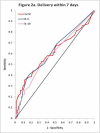The antibiotic treatment of PPROM study: systemic maternal and fetal markers and perinatal outcomes
- PMID: 22000668
- PMCID: PMC3262066
- DOI: 10.1016/j.ajog.2011.08.028
The antibiotic treatment of PPROM study: systemic maternal and fetal markers and perinatal outcomes
Abstract
Objective: We sought to correlate maternal and cord blood cytokine and intercellular adhesion molecule-1 levels with antibiotic exposure and perinatal outcomes after conservatively managed preterm premature rupture of the membranes.
Study design: Conservatively managed women with preterm premature rupture of the membranes at 24-32 weeks had blood sampling at randomization (n = 222) and delivery (n = 121). Plasma from these, and umbilical cord blood (n = 196), was stored at -70°C. Interleukin (IL)-6, IL-10, granulocyte colony-stimulating factor (G-CSF), tumor necrosis factor-α, and intercellular adhesion molecule-1 levels were assessed for associations with antibiotic treatment, latency, amnionitis, neonatal sepsis, pneumonia, and composite neonatal morbidity.
Results: Cord blood IL-6 and G-CSF were higher than maternal levels. Antibiotic treatment lowered only maternal G-CSF (P = .01). Elevated maternal cytokine levels were associated with delivery within 7 days and with development of chorioamnionitis. All umbilical cord blood markers were increased with amnionitis (P ≤ .01 for each). No maternal marker was associated with neonatal morbidities. Cord G-CSF and IL-6 were increased with neonatal sepsis within 72 hours of birth (P = .004 for both), and with composite neonatal morbidity (P = .001 and .002, respectively). Maternal and umbilical cord cytokine levels demonstrated low predictive values for perinatal outcomes.
Conclusion: Umbilical cord blood cytokine values are higher than maternal levels, suggesting significant fetal/placental contribution. Maternal and umbilical cord cytokine levels are not adequately predictive to be used clinically.
Copyright © 2012 Mosby, Inc. All rights reserved.
Figures




References
-
- ACOG Committee on Practice Bulletins-Obstetrics ACOG Practice Bulletin No. 80: premature rupture of membranes. Clinical management guidelines for obstetrician-gynecologists. Obstet Gynecol. 2007;109:1007–19. - PubMed
-
- Mercer BM. Preterm premature rupture of the membranes. Obstet Gynecol. 2003;101:178–93. - PubMed
-
- Chow SS, Craig ME, Jones CA, Hall B, Catteau J, Lloyd AR, Rawlinson WD. Differences in amniotic fluid and maternal serum cytokine levels in early midtrimester women without evidence of infection. Cytokine. 2008;44:78–84. - PubMed
-
- Murtha AP, Greig PC, Jimmerson CE, Herbert WNP. Maternal serum interleukin-6 concentration as a marker for impending preterm delivery. Obstet Gynecol. 1998;91:161–4. - PubMed
Publication types
MeSH terms
Substances
Grants and funding
- HD36801/HD/NICHD NIH HHS/United States
- HD27861/HD/NICHD NIH HHS/United States
- UG1 HD027869/HD/NICHD NIH HHS/United States
- U10 HD040544/HD/NICHD NIH HHS/United States
- HD27869/HD/NICHD NIH HHS/United States
- U10 HD027861/HD/NICHD NIH HHS/United States
- U10 HD027883/HD/NICHD NIH HHS/United States
- U10 HD027869/HD/NICHD NIH HHS/United States
- U10 HD027917/HD/NICHD NIH HHS/United States
- U10 HD027860/HD/NICHD NIH HHS/United States
- HD27889/HD/NICHD NIH HHS/United States
- U01 HD019897/HD/NICHD NIH HHS/United States
- HD27915/HD/NICHD NIH HHS/United States
- U01 HD036801/HD/NICHD NIH HHS/United States
- HD27860/HD/NICHD NIH HHS/United States
- UG1 HD027915/HD/NICHD NIH HHS/United States
- HD21414/HD/NICHD NIH HHS/United States
- U10 HD027905/HD/NICHD NIH HHS/United States
- U10 HD021414/HD/NICHD NIH HHS/United States
- U10 HD027915/HD/NICHD NIH HHS/United States
- HD27917/HD/NICHD NIH HHS/United States
- U10 HD036801/HD/NICHD NIH HHS/United States
- HD21434/HD/NICHD NIH HHS/United States
- U24 HD036801/HD/NICHD NIH HHS/United States
LinkOut - more resources
Full Text Sources

